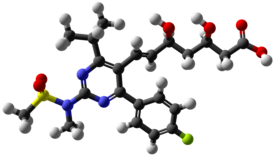 | |
 | |
| Clinical data | |
|---|---|
| Pronunciation | /roʊˈsuːvəstætɪn/ roh-SOO-və-stat-in |
| Trade names | Crestor, others |
| Other names | Rosuvastatin calcium (USAN US) |
| AHFS/Drugs.com | Monograph |
| MedlinePlus | a603033 |
| License data |
|
| Pregnancy category |
|
| Routes of administration | Oral (by mouth) |
| ATC code | |
| Legal status | |
| Legal status | |
| Pharmacokinetic data | |
| Bioavailability | 20%[5][6] |
| Protein binding | 88%[5][6] |
| Metabolism | Liver: CYP2C9 (major) and CYP2C19-mediated; ~10% metabolized[5][6] |
| Metabolites | N-desmethyl rosuvastatin (major; 1/6–1/9 of rosuvastatin activity)[4] |
| Elimination half-life | 19 hours[5][6] |
| Excretion | Feces (90%)[5][6] |
| Identifiers | |
| |
| CAS Number |
|
| PubChem CID | |
| IUPHAR/BPS | |
| DrugBank |
|
| ChemSpider | |
| UNII |
|
| KEGG | |
| ChEBI |
|
| ChEMBL |
|
| PDB ligand | |
| CompTox Dashboard (EPA) | |
| ECHA InfoCard | 100.216.011 |
| Chemical and physical data | |
| Formula | C22H28FN3O6S |
| Molar mass | 481.54 g·mol−1 |
| 3D model (JSmol) | |
| |
| |
| | |
Rosuvastatin, sold under the brand name Crestor among others, is a statin medication, used to prevent cardiovascular disease in those at high risk and treat abnormal lipids.[6] It is recommended to be used together with dietary changes, exercise, and weight loss.[6] It is taken orally (by mouth).[6]
Common side effects include abdominal pain, nausea, headaches, and muscle pains.[6] Serious side effects may include rhabdomyolysis, liver problems, and diabetes.[6] Use during pregnancy may harm the baby.[6] Like all statins, rosuvastatin works by inhibiting HMG-CoA reductase, an enzyme found in the liver that plays a role in producing cholesterol.[6]
Rosuvastatin was patented in 1991, and approved for medical use in the United States in 2003.[6][7] It is available as a generic medication.[6] In 2022, it was the thirteenth most commonly prescribed medication in the United States, with more than 37 million prescriptions.[8][9] In Australia, it was one of the top 10 most prescribed medications between 2017 and 2023.[10]
- ^ "Rosuvastatin Use During Pregnancy". Drugs.com. 27 September 2019. Archived from the original on 30 November 2020. Retrieved 14 March 2020.
- ^ "Crestor Product information". Health Canada. 25 April 2012. Archived from the original on 9 July 2021. Retrieved 9 July 2021.
- ^ "Crestor 10mg film-coated tablets - Summary of Product Characteristics (SmPC)". (emc). 29 September 2020. Archived from the original on 9 July 2021. Retrieved 9 July 2021.
- ^ a b Cite error: The named reference
Crestor FDA labelwas invoked but never defined (see the help page). - ^ a b c d e Aggarwal RK, Showkathali R (June 2013). "Rosuvastatin calcium in acute coronary syndromes". Expert Opinion on Pharmacotherapy. 14 (9): 1215–27. doi:10.1517/14656566.2013.789860. PMID 23574635. S2CID 20221457.
- ^ a b c d e f g h i j k l m n "Rosuvastatin Calcium Monograph for Professionals". Drugs.com. American Society of Health-System Pharmacists (AHFS). Archived from the original on 24 December 2018. Retrieved 24 December 2018.
- ^ Fischer J, Ganellin CR (2006). Analogue-based Drug Discovery. John Wiley & Sons. p. 473. ISBN 9783527607495. Archived from the original on 12 January 2023. Retrieved 27 August 2020.
- ^ "The Top 300 of 2022". ClinCalc. Archived from the original on 30 August 2024. Retrieved 30 August 2024.
- ^ "Rosuvastatin Drug Usage Statistics, United States, 2013 - 2022". ClinCalc. Retrieved 30 August 2024.
- ^ "Medicines in the health system". Australian Institute of Health and Welfare. 2 July 2024. Retrieved 30 September 2024.